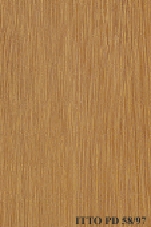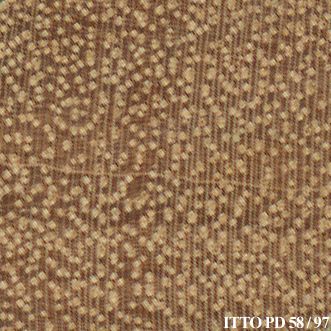
CHENGAL (Neobalanocarpus heimii)
Trade Name
Chengal
Scientific Name
Neobalanocarpus heimii (King) P. Ashton
Family
DIPTEROCARPACEAE
Common Names
Tjengal; Taknian chan tamaeo (Thailand); Takian-chan (Thailand); Takhian chan ta maeo (Thailand); Takhian chan (Thailand); Penak tambaga; Penak sabut; Penak lilin; Penak bunga; Penak (Malaysia); Chingal; Chi-nga mas; Chengal (Malaysia); Chengai batu; Chengai (Malaysia)
Scientific Name Synonyms
Balanocarpus heimii King
Description Of The Tree
Botanical Description
It is a very large tree, sometimes over 60 m tall. The bole is straight, branchless for 30 m or more, with an average diameter of 90 cm. It presents prominent buttresses.
Natural Habitat
It is widespread in mixed dipterocarp forests below 1,000 m of altitude, especially on well drained soils. It is known or inferred that the harvesting of specimens from the wild for international trade has, or may have, a detrimental impact on the specie
Natural Distribution
This species is widely distributed in the Malay Peninsula including southernmost Thailand.
Wood Identification
Anatomic Description Of Wood
Wood diffuse porous. Vessels exclusively solitary (over 90%). Tyloses common. Vestured pits. Vessel-ray pits reticulate and/or foraminate. Vascular/vasicentric tracheides present. Simple perforation plates. Intervessel pits medium, 7 to 10 micras. Paratracheal axial parenchyma scanty and/or vasicentric. Axial parenchyma scalariform. Prismatic crystals in chambered axial parenchyma cells and/or in fibers. Rays storied. Body ray cells procumbent with over 4 rows of upright and/or square marginal cells (Kribs-I). Body ray cells procumbent with mostly 2 to 4 rows of upright and/or square marginal cells (Kribs-II). Body ray cells procumbent with one row of uprigh Fibers storied.
-
 Wood Macro Photo Tangential Plane
Wood Macro Photo Tangential Plane
-
 Wood Micro Photo Of Transversal Section
Wood Micro Photo Of Transversal Section
Availability
Cites Status
Unrestricted
General Wood Description
Color
The sapwood is white or pale yellow. The freshly-cut heartwood is pale yellow-brown, turning to dark reddish or purple-brown, often with attractive greenish tinge.
COLOR INDEX (1=Black, 7=Light yellow,white)
5
Grain
The grain is usually slightly interlocked or wavy, rarely straight.
Texture
Texture is mostly fine to medium.
Luster
The surface is slightly lustrous.
Natural Durability
Heartwood is very resistant to decay. It also has a reputation of being highly resistant to most species of termites.
Natural durability index (1= Very high durability, 7=Vey low durability)
2
Silica Content
Silica Content: Silica content is negligible. Amounts over 0.05% may affect wood processing. Silica Value: 0
Resistance To Impregnation
The sapwood is moderately permeable, but the heartwood is impermeable to preservative treatment.
Wood Physical Properties
Basic Density or Specific Gravity (O.D. weight/vol. green) (g/cm³)
0.82
Air-dry Density (Weight and volume at 12%MC) (g/cm³)
0.95
Total shrinkage Tangential (Saturated to 0%MC) (%)
7.4
Total shrinkage Radial (Saturated to 0%MC) (%)
3.0
Drying Defects
Ease of Drying: Air seasoning is reported to be difficult. Drying Defects: It has a tendency to warp and collapse. Kiln Schedules: Reconditioning treatment at 20% of moisture content is recommended to recover wood with collapse. Kiln drying of heavier grades of eucalyptus timber is only practicable in boards up to 25 mm in thickness. It is strongly recommended to air dry the wood to
Recommended Dry Kiln Schedule
UK-B; US-T2-C2
Dimensional stability ratio (Total Tangential Shrinkage %/Total Radial Shrinkage %)
2.5
Wood Chemical Properties
Wood Mechanical Properties
Bending Strength (MOR),12%MC (kgf/cm²)
1514
Stiffness (MOE) 12%MC (kgf/cm²)
199334
Compression parallel to fiber 12%MC (kgf/cm²)
764
Compression perpendicular to fiber 12%MC (kgf/cm²)
122
Shear strength radial 12%MC (kgf/cm²)
143
Janka hardness (side) 12%MC (kgf)
957
Workability
Sawing
Despite its density, sawmilling of this species is reportedly fair.
Rotary Veneer Cutting
This species can be used for lamination.
Sliced Veneer
This species can be used for lamination.
Machining
Machining of this species is easy to fair. Presence of resins is sometimes troublesome.
Planing
Planing operations are rather easy.
Moulding
It is easy to mold.
Boring
This species is easy to bore.
Mortising
Mortising of this species is reported to be easy.
Nailing
It nails well, but pre-boring is recommended.
Sanding
Sanding properties are rated as good to fair.
REFERENCED USES
End Uses Summary
EXTERIOR GENERAL, bridges, poles, crossties, HOUSING GENERAL, flooring, SPORTS, TOOLS, agricultural tools, CONTAINERS, cooperage, truck bodies, truck flooring, NAVAL CONSTRUCTION
Exterior General
- 1 - Tabela de resultados de ensaios fisicos e mecanicos
Bridges
- 2 - 25 madeiras da amazonia de valor comercial, caracterizacao, macroscopica, usos comuns e indices qualificativos
Poles
- 3 - Estudo dendrologico e determinacao das caracteristicas fisicas e mecanicas do genipapo (Genipa americana)
Crossties
- 8 - Maderas latinoamericas. III, Podocarpus standleyi ,Podocarpus oleifolius, Drims granadensis, Magnolia poasana y Didymopanax pittieri
General Housing
- 10 - Silica in Timbers
Flooring
- 14 - Handbook of Hardwoods
Sports
- 38 - Annual Review and Assessment of the World Timber Situation 1998-ITTO
Tools
- 42 - Utilización Industrial de Nuevas Especies Forestales en el Perú.
Agricultural Tools
- 44 - Atlas of Peruvian Woods
Containers
- 50 - Properties of imported tropical woods
Cooperage
- 51 - Recopilacion de propiedades mecanicas de maderas creciendo en Chile
Truck Body
- 53 - Timbers of the New World
Truck Flooring
- 54 - Bulletin of the Government Forest Experiment Station N.157: Identification of Tropical Woods
Shipbuilding
- 55 - Tropical Timber Atlas of Latin America
Please Provide Information To View Producer Information